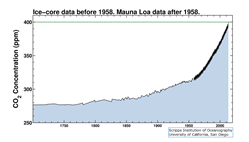Full Transparency
Our editorial transparency tool uses blockchain technology to permanently log all changes made to official releases after publication. However, this post is not an official release and therefore not tracked. Visit our learn more for more information.
On May 9, the Scripps/NOAA atmospheric resarch facility at Mauna Loa Observatory in Hawaii – the oldest continuous carbon dioxide measurement station in the world – determined that our planet had crossed the threshold of a new environmental era. For the first time since measurements began in 1958, the daily mean concentration of CO2 in the atmosphere exceeded 400 parts per million (ppm).
Researchers say that over the last 800,000 years, atmospheric CO2 levels fluctuated from 180 ppm during ice ages and 280 ppm during interglacial warm periods. More recently, prior to the Industrial Revolution in the 19th century, the average global CO2 level was about 280 ppm. Today's rate of increase is more than 100 times faster than the increase that occurred when the last ice age ended.

You can see the progressive increase of CO2 through the “Keeling Curve.” It’s the record of an extensive survey of atmospheric carbon dioxide started in 1958 by the late Charles David Keeling – whose work was motivated by the suggestion that atmospheric carbon dioxide levels might be increasing due to the burning of fossil fuels with potential consequences for global climate.
The rate of increase has accelerated since the measurements started, from about 0.7 ppm per year in the late 1950s to 2.1 ppm per year during the last 10 years. According to NOAA, the evidence is conclusive that the burning of coal, oil, and natural gas is driving the growth of global CO2 emissions.
But what does crossing the 400 ppm CO2 threshold mean for us? After all, this number means that for every million air molecules, 400 (or 0.04 percent) are carbon dioxide.
"These are not small changes in percent terms,” says Ralph Keeling, who took over the monitoring project at Scripps in 2005 after his father died. “Two or 3 million years ago was the last time we had concentrations in this range, so we're moving into territory that's almost outside the scope of human existence on the planet at this point.”
“But what happens from here on still matters to climate and it's still under our control,” Keeling adds. “It mainly comes down to how much we continue to rely on fossil fuels for energy.”
When you consider that CO2 we emit now can remain in the atmosphere for thousands of years, you realize that we all need to take action to reduce our personal and commercial carbon emissions – not only for ourselves but for many generations to come.
Click here to see what Verizon is doing now to cut its carbon intensity by 50 percent by 2020. And, to learn about our recently announced $100 million commitment to renewable solar and clean fuel cell energy technologies checkout this post from our Chief Sustainability Officer James Gowen.
